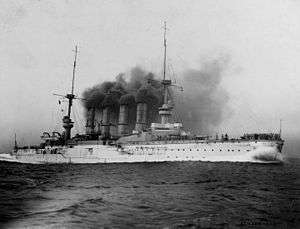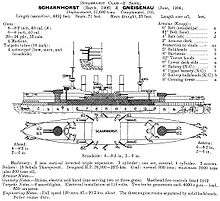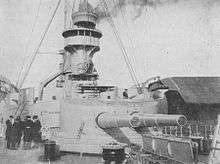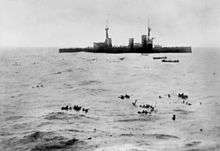Scharnhorst-class cruiser
 SMS Scharnhorst | |
| Class overview | |
|---|---|
| Name: | Scharnhorst-class cruiser |
| Operators: |
|
| Preceded by: | Roon class |
| Succeeded by: | SMS Blücher |
| Built: | 1905–1908 |
| In service: | 1907–1914 |
| Completed: | Two ordered and commissioned |
| Lost: | 2 |
| General characteristics | |
| Type: | Armored cruiser |
| Displacement: | 12,985 t (12,780 long tons; 14,314 short tons) full load |
| Length: | 144.6 m (474 ft 5 in) |
| Beam: | 21.6 m (70 ft 10 in) |
| Draft: | 8.37 m (27 ft 6 in) |
| Installed power: |
|
| Propulsion: | 3 shaft triple expansion engines |
| Speed: | 22.7 knots (42 km/h) |
| Crew: |
|
| Armament: |
|
| Armor: |
|
The Scharnhorst class was the last traditional class of armored cruisers built by the Kaiserliche Marine. The class comprised two ships, Scharnhorst and Gneisenau. They were larger than the Roon-class cruisers that preceded them; the extra size was used primarily to increase the main armament of 21 cm (8.2 inch) guns from four to eight. The ships were the first German cruiser to reach equality with their British counterparts.[1] The ships were named after 19th century Prussian army reformers, Gerhard von Scharnhorst and August von Gneisenau.
Built for overseas service, Scharnhorst and Gneisenau were assigned to the East Asia Squadron in 1909 and 1910, respectively. Scharnhorst relieved the old armored cruiser Fürst Bismarck as the squadron flagship, which had been on station since 1900. Both ships had short careers; shortly before the outbreak of World War I, the ships departed the German colony at Tsingtao. On 1 November 1914, the ships destroyed a British force at the Battle of Coronel and inflicted upon the Royal Navy its first defeat since the Battle of Plattsburgh in 1814.[2] The East Asia Squadron, including both Scharnhorst-class ships, was subsequently annihilated at the Battle of the Falkland Islands on 8 December.
Design

General characteristics
The ships of the class were 144.6 meters (474 ft) long overall, and 143.8 m (472 ft) long at the waterline. They had a beam of 21.6 m (71 ft), a draft of 8.4 m (27 ft 7 in), and displaced 11,616 metric tons (11,433 long tons; 12,804 short tons) standard, and 12,985 t (12,780 long tons; 14,314 short tons) at full load. The ships' hulls were constructed of transverse and longitudinal steel frames, over which the outer hull plating was riveted. The vessels had 15 watertight compartments and a double bottom that ran for 50% of the length of the hull.[3]
The ships had a standard crew of 38 officers and 726 enlisted men. Scharnhorst, as the squadron flagship, had a larger crew, including an additional 14 officers and 62 men. Gneisenau, when serving as the squadron second command flagship, had an extra staff of 3 officers and 25 men. The ships carried a number of smaller vessels, including two picket boats, two launches, one pinnace, two cutters, three yawls, and one dinghy.[3]
Machinery
The Scharnhorst-class ships used the same powerplant as in the preceding Roon class: three 3-cylinder triple expansion engines.[4] Each engine drove a single propeller; the center shaft on Scharnhorst was 4.7 m (15 ft) in diameter while the outer two were 5 m (16 ft) wide. Gneisenau's screws were slightly smaller, at 4.6 m (15 ft) wide on the center shaft and 4.8 m (16 ft) on the outer pair. The triple expansion engines were supplied with steam by 18 coal-fired marine-type boilers with 36 fire boxes. The engines were designed to provide 26,000 indicated horsepower, though on trials they achieved higher figures—28,782 ihp for Scharnhorst and 30,396 ihp for Gneisenau. The ships were rated at a top speed of 22.5 knots (41.7 km/h; 25.9 mph), though on trials Scharnhorst steamed at a maximum of 23.5 knots (43.5 km/h; 27.0 mph), while Gneisenau ran at 23.6 knots (43.7 km/h; 27.2 mph).[3] The vessels carried 800 t (790 long tons; 880 short tons) of coal normally, though they were capable of storing up to 2,000 t (2,000 long tons; 2,200 short tons) of coal. This provided a maximum range of 4,800 nautical miles (8,900 km; 5,500 mi) at a cruising speed of 14 knots (26 km/h; 16 mph).[5] The ships had a single rudder.[3]
The vessels also carried the same electrical plant as in the older Roon-class ships. It consisted of four turbo-generators that delivered 260 kilowatts at 110 volts.[6] The Scharnhorst-class ships were the last cruisers built by Germany to be equipped with generators that put out power at 110 volts; the subsequent design, Blücher, had generators that ran at 225 volts.[7]
Armament

The ships' main battery armament consisted of eight 21 cm (8.3 in) SK L/40 guns,[lower-alpha 1] four in twin gun turrets, one fore and one aft of the main superstructure, and the remaining four were mounted in single wing turrets. The 21 cm guns fired a 108 kg (238 lb) armor-piercing projectile at a muzzle velocity of 780 metres per second (2,600 ft/s). The guns had a rate of fire of between 4–5 rounds per minute.[8] The guns were supplied with a total of 700 rounds.[3] The guns mounted in the twin turrets could elevate to 30 degrees, which enabled a maximum range of 16,300 metres (17,800 yd). The single turrets could only elevate to 16 degrees, and so their range was correspondingly lower at 12,400 metres (13,600 yd). The twin turrets could train to approximately 150 degrees in either direction from the centerline.[8]
Secondary armament included six 15 cm (5.9 in) SK L/40 guns in MPL casemates.[lower-alpha 2] These guns had a fired armor-piercing shells at a rate of 4–5 per minute. The ships carried 170 shells per gun, for a total of 1,020 rounds total. The guns could depress to −7 degrees and elevate to 20 degrees, for a maximum range of 13,700 metres (15,000 yd). They were manually elevated and trained.[9]
The ships were also armed with eighteen 8.8 centimetres (3.5 in) guns mounted in casemates. They fired 10 kg (22 lb) shells at a muzzle velocity of approximately 620 metres per second (2,000 ft/s). The ship carried 150 shells per gun, for a total of 2,700 rounds. They were capable of engaging targets out to 11,000 m (12,000 yd). As with the larger 15 cm guns, the 8.8 cm weapons were manually elevated and trained.[10]
As was customary for warships of the period, the Scharnhorst-class ships were equipped with four 45 cm (18 in) submerged torpedo tubes. One was mounted in the bow, one on each broadside, and the fourth was placed in the stern. The ships were supplied with a total of 11 torpedoes.[3] The weapons were the C/03 type, which weighed 662 kilograms (1,459 lb) and carried a 176 kilograms (388 lb) high-explosive warhead. At a speed of 31 knots (57 km/h; 36 mph), the torpedoes had an effective range of 1,500 metres (1,600 yd); when set at a slower speed of 26 knots (48 km/h; 30 mph), the weapons could hit targets out to twice the distance, at 3,000 metres (3,300 yd).[11]
Armor
As was the standard for German warships, the ships of the Scharnhorst class were protected by Krupp armor. They had an armor belt that was 150 mm (5.9 in) thick in the central portion of the ship, where the most important areas were located. The belt decreased to 80 mm (3.1 in) on either end of the central citadel, and down to nothing at the bow and stern. The entire belt was backed with teak planking. The main armored deck ranged in thickness from 60 mm (2.4 in) over critical areas and down to 35 mm (1.4 in) elsewhere. The deck sloped down to the belt; this portion was between 40–55 mm (1.6–2.2 in) thick. The forward conning tower had 200 mm (7.9 in) thick sides and a 30 mm (1.2 in) thick roof. The rear conning tower was less well-armored, with sides that were only 50 mm (2.0 in) thick and a roof that was 20 mm (0.79 in) thick. The main battery gun turrets had 170 mm (6.7 in) thick sides and 30 mm (1.2 in) thick roofs, while the amidships guns were protected with 150 mm (5.9 in) thick gun shields and 40 mm (1.6 in) thick roofs. The 15 cm guns were armored with 80 mm (3.1 in) thick shields.[3]
Ships
| Name | Namesake | Builder | Laid down | Launched | Commissioned | Fate |
|---|---|---|---|---|---|---|
| Scharnhorst | Generalleutnant Gerhard von Scharnhorst | Blohm & Voss, Hamburg | 3 January 1905 | 22 June 1906 | 24 October 1907 | Sunk during the Battle of the Falkland Islands, 8 December 1914 |
| Gneisenau | Generalfeldmarschall August Graf Niedhardt von Gneisenau | AG Weser, Bremen | 28 December 1904 | 14 June 1906 | 6 March 1908 |
Service history
Upon commissioning, both ships of the class were assigned to the German East Asia Squadron, with Scharnhorst serving as Admiral Maximilian von Spee's flagship. Scharnhorst and Gneisenau were regarded as well-trained vessels; both ships won awards for their excellence at gunnery.[12] At the start of World War I, the two ships were in the Caroline Islands on a routine cruise; the rest of von Spee's squadron was dispersed around the Pacific. The declaration of war by Japan on Germany convinced von Spee to consolidate his force with the cruisers Leipzig and Dresden from the American station, and head for Chile to refuel. The flotilla would then attempt to return to Germany via the Atlantic Ocean. Admiral von Spee also intended to attack the three British cruisers under the command of Admiral Christopher Cradock, and any British shipping encountered.[13] On 22 September, Scharnhorst and Gneisenau approached the island of Papeete in French Polynesia with the intention of seizing the coal stockpiled in the harbor. The ships conducted a short bombardment that resulted in the sinking of the old gunboat Zélée. However, von Spee feared that the harbor had been mined, and decided to avoid the risk. The French had also set fire to the coal stocks to prevent the Germans from using the coal.[14]
Battle of Coronel
At approximately 17:00 on 1 November 1914, the East Asia Squadron encountered Cradock's ships off Coronel. Because the German ships had an advantage in speed, von Spee was able to keep the distance to 18 kilometers, before closing to 12 km (1.2×1013 nm) to engage the British flotilla at 19:00. Scharnhorst hit Good Hope some 34 times; at least one of the shells penetrated Good Hope's ammunition magazines, which resulted in a tremendous explosion that destroyed the ship. The light cruiser Nürnberg closed to point-blank range to attack Monmouth; after a severe pummeling, Monmouth sank as well. The British light cruiser Glasgow and the auxiliary cruiser Otranto both escaped under the cover of darkness. First Sea Lord Jackie Fisher remarked that it was "the saddest naval action of the war."[15] The defeat was the first to be inflicted on the Royal Navy since the 1814 Battle of Plattsburgh. After news of the battle reached Kaiser Wilhelm II in Berlin, he ordered 300 Iron Crosses to be awarded to the men of von Spee's squadron. After refueling in Valparaiso, the East Asia Squadron departed for the Falkland Islands, in order to destroy the British wireless transmitter located there.[15]
Battle of the Falkland Islands

Some six hours after news of the battle reached England, Admiral Fisher ordered Admiral John Jellicoe, the commander of the Grand Fleet, to detach the battlecruisers Invincible and Inflexible to hunt down the German ships. Vice Admiral Doveton Sturdee was placed in command of the flotilla, which also included the armored cruisers Carnarvon, Cornwall, Defence, and Kent, and the light cruisers Bristol and Glasgow, which had survived Coronel.[15] Sturdee's ships reached the Falklands by the morning of 8 December, shortly before von Spee's squadron arrived. The British spotted the East Asia Squadron at 09:40; von Spee was unaware that the British had sent the two battlecruisers, and when he observed them, he ordered his ships to withdraw. Despite the head start, the fast battlecruisers quickly caught up with the worn-out German ships, which had just completed a 16,000 mile voyage without repairs.[16]
At approximately 13:20, the battlecruisers opened fire at a range of 14 kilometres (8.7 mi). After a two-hour-long battle, Scharnhorst was dead in the water and listing heavily. The ship was sunk shortly thereafter. Gneisenau had been hit more than 50 times at close range; the crew gave three cheers for the Kaiser before the vessel sank. Nürnberg and Leipzig were also sunk, though Dresden managed to escape temporarily, before she too was destroyed off Juan Fernández Island. Some 2,200 men were killed, among them Admiral von Spee.[17]
Notes
Footnotes
- ↑ In Imperial German Navy gun nomenclature, "SK" (Schnelladekanone) denotes that the gun is quick firing, while the L/40 denotes the length of the gun. In this case, the L/40 gun is 40 calibers, meaning that the gun barrel is 40 times as long as it is in diameter.
- ↑ MPL stands for Mittel-Pivot-Lafette (Central pivot mounting). See: NavWeaps (Ammunition, Guns and Mountings).
Citations
References
| Wikimedia Commons has media related to Scharnhorst class cruiser (1907). |
- Gilbert, Martin (2004). The First World War: A Complete History. Macmillan. ISBN 978-0-8050-7617-2.
- Gröner, Erich (1990). German Warships: 1815–1945. Annapolis: Naval Institute Press. ISBN 978-0-87021-790-6. OCLC 22101769.
- Halpern, Paul G. (1995). A Naval History of World War I. Annapolis: Naval Institute Press. ISBN 978-1-55750-352-7. OCLC 57447525.
- Herwig, Holger (1998) [1980]. "Luxury" Fleet: The Imperial German Navy 1888–1918. Amherst, New York: Humanity Books. ISBN 978-1-57392-286-9. OCLC 57239454.
Online sources
- DiGiulian, Tony (25 February 2009). "Germany 21 cm/40 (8.27") SK L/40". NavWeaps.com. Retrieved 3 August 2009.
- DiGiulian, Tony (20 October 2008). "German 15 cm/40 (5.9") SK L/40". NavWeaps.com. Retrieved 3 August 2009.
- DiGiulian, Tony (29 October 2006). "German 8.8 cm/35 (3.46") SK L/35". NavWeaps.com. Retrieved 3 August 2009.
- DiGiulian, Tony (22 May 2012). "Germany: Ammunition, Guns and Mountings Definitions". NavWeaps.com. Retrieved 16 July 2012.
- DiGiulian, Tony (21 April 2007). "German Torpedoes Pre-World War II". NavWeaps.com. Retrieved 3 August 2009.
